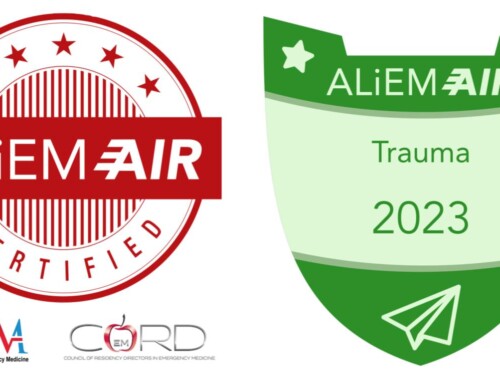 Which is a better prognostic tool in geriatric trauma, traditional vital signs or lactate level?
Which is a better prognostic tool in geriatric trauma, traditional vital signs or lactate level?
Meet Norma Nuance (NN), a 70-year-old woman with CAD, HTN, HLD, DM, and mild dementia. She was involved in an MVC as the restrained driver with questionable LOC. She arrives in your ED and appears confused, but has a history of dementia. There are no family members to tell you her baseline. Her BP is 120/80, and her HR is 90. She is not calling out in pain, but does mumble about her left arm when you ask if she is hurting. You think she may have sprained her wrist.
Now meet Frankie Obvious (FO), a 22-year-old male, who was the helmeted driver of a motorcycle that hit a car. He was thrown from the motorcycle, and arrives combative and yelling with a HR of 130 and a BP of 100/70.
Based on their vital signs, which patient is going to receive more immediate attention? Your lactate level is pending…
What are causes of an elevated lactate?
Lactate can become elevated through a number of different mechanisms. Classically it is thought of as a by-product of anaerobic metabolism that can occur due to tissue hypoxia, or decoupling of oxidative phosphorylation by toxins. However lactate is more often elevated as a result of activation of the sympathetic system. With all the EMCrit recent discussion of lactate clearance as a good, non-invasive measure of responsiveness to early goal directed therapy (EGDT) in sepsis, I have been ordering more lactates. Almost anyone who has a fever, who has signs of an infection and SIRS without a fever, or who looks like they could be hiding something serious like occult hypoperfusion or mesenteric ischemia gets a lactate. A negative lactate certainly doesn’t rule out serious pathology, but a positive lactate catches my attention, particularly in the elderly, who may not be able to mount a lactate as robustly as younger patients.
What about lactate in trauma?
Lactate levels in trauma, however, have not been discussed as often. Is it a useful prognostic indicator? How important is it? Can we detect occult hypoperfusion in trauma patients with a lactate? Several papers have looked at the prognostic utility of lactates and base deficits in elderly trauma patients. Not surprisingly, elevated lactates (or base deficits) are predictive of mortality. More importantly, though, this held true in patients with “normal” vital signs, and in some studies lactate level was a better predictor of outcome than vital signs.
Why Vital Signs Are Not Enough
In trauma patients with hypotension or tachycardia, the physician is ‘alerted’ to the fact that the patient’s physiology is being stressed. However, some patients may be able to compensate enough that their vital signs appear normal, even if they are at high risk for decompensation. Or their vitals may be inappropriately normal because they are unable to elevate their heart rate due to age, cardiac disease, or beta-blockers. An elevated lactate could help identify patients early on who have normal vital signs with occult hypoperfusion.
Why a focus on the elderly?
Elderly patients who have tachycardia or hypotension, like patients at any age, should ring warning bells for potential deterioration. However, elderly patients may be particularly prone to having ‘normal’ vital signs despite serious and impending hemodynamic instability. One study related mortality to presenting vital signs in young and elderly adults following blunt trauma and reported the following 1 :
Mortality increases considerably in the elderly patients for HRs of 90 beats per minute (bpm), an association not seen until HR of 130 bpm in the young group. Mortality significantly increases with systolic blood pressure (SBP) 110 Hg in the geriatric patients but not until a SBP of 95 mm Hg in the young patients.
Revisiting the two cases
Let’s return to those two patients, 70-year-old Norma Nuance and 22-year-old Frankie Obvious.
FO’s vital signs are abnormal and should be addressed immediately. But it is easy to see how NN could be overlooked, with her “normal vital signs” and her altered mental status attributed to her dementia. Let’s dig a little deeper. NN’s BP is usually 170/110, so this is a 50 point drop for her. In addition, she is on 60 mg of metoprolol BID, so elevating her HR to 90 in spite of the beta blockers represents a marked sympathetic response to her injuries or hypoperfusion. Unbeknownst to you, she is also on clopidogrel, and her current mental status is not at all her baseline. Now an intra-cranial hemorrhage is worrisome. She is mumbling about her left arm hurting not because it is sprained, but because she is actually having an MI that precipitated the MVC.
NN and FO could both be at risk for death, even though NN has “normal vitals”.
What do the Studies on Lactate in Geriatric Trauma Show?
Here are a few studies that have looked at lactate in elderly trauma patients:
- An elevated lactate (>2.5 mmol/L) in elderly trauma patients (>65 yo) had an odds ratio (OR) of 2.62 (p<0.001) for mortality after adjustment for other factors. 2
- In elderly patients with SBP > 110 mmHg, those with an elevated lactate (>2.5 mmol/L) had an OR for 24-hour mortality of 7.4 (p=0.0098). 3
- For elderly trauma patients with occult hypoperfusion (normal VS and ELEVATED lactate) had longer ICU stays of 8.6 days vs 3 days (p=0.01) and an increased likelihood of discharge to a nursing facility compared with patients who had normal VS and NORMAL lactate. 4
- The degree of elevation in lactate correlated with morality. Normal (0-2.4 mmol/L), moderately elevated (2.5-4 mmol/L), and severely elevated (>4 mmol/L) lactate levels in elderly blunt trauma patients carried mortality rates of approximately 15%, 23%, and 40%. 5
Like all studies, the ones listed above have their limitations and confounders. However, these and other studies suggest that lactate level is a useful tool for detecting occult hypoperfusion, and in some cases is a better predictor of mortality than vital signs in elderly trauma patients. Neville et al 3 nicely summarized as follows:
“The current study supports the use of arterial lactate and base deficit testing to identify elderly normotensive trauma patients who are at increased risk of death and who might benefit from early monitoring and admission to higher levels of care”
Bottom line: Hyperlactatemia in an elderly patients who sustain blunt trauma should set off metaphorical lights and sirens.
So which is more important: vital signs or lactate?
 The answer, of course, is BOTH.
The answer, of course, is BOTH.
- Be very concerned if you see abnormal vitals, but be suspicious of “normal” vitals in the elderly. Consider making your threshold for tachycardia lower, and your threshold for hypotension higher, 1,6 particularly in patients who have underlying diseases or medications that will confound your assessments.
- Highly consider sending a lactate. This may help you catch some of the patients with occult hypoperfusion who have “normal” vital signs. It may help you pick out those who are at increased risk of decompensation and death, so that they can be more closely monitored and receive earlier intervention.
Welcome to Geriatric EM
This has been the first in a monthly series on Geriatric Emergency Medicine. If you have feedback or ideas for topics that would be of interest, please send an email or leave a comment.




